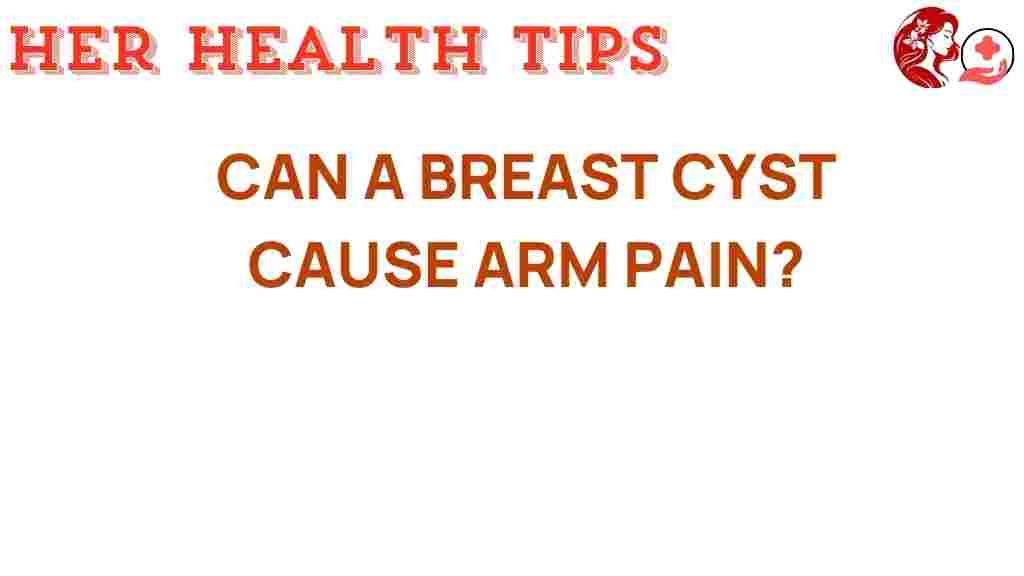Unraveling the Mystery: Can a Breast Cyst Cause Arm Pain?
When women experience arm pain, it can be a source of concern and anxiety. One common question that arises is whether a breast cyst can cause arm pain. Understanding this connection is crucial for women’s health, as it can help in diagnosing health concerns and managing symptoms effectively. In this article, we will delve into the relationship between breast cysts and arm pain, explore common symptoms, discuss diagnosis, and debunk some medical myths surrounding this topic.
Understanding Breast Cysts
A breast cyst is a fluid-filled sac that develops in the breast tissue. They are quite common, especially in women aged 30 to 50, and can vary in size from very small to large. Most breast cysts are benign, meaning they are not cancerous, but they can cause discomfort and concern due to their association with breast health.
Symptoms of Breast Cysts
Breast cysts can present a range of symptoms, including:
- Localized breast pain or tenderness: This is often the most noticeable symptom.
- Changes in breast texture: The area around the cyst may feel lumpy or bumpy.
- Fluid discharge: In some cases, cysts may leak fluid, leading to discharge from the nipple.
- Size fluctuation: Cysts can change in size during the menstrual cycle.
While breast cysts primarily cause breast-related symptoms, many women wonder if they can also lead to arm pain.
Can Breast Cysts Cause Arm Pain?
The short answer is that breast cysts typically do not cause arm pain directly. However, there are some indirect pathways that could lead to discomfort in the arm area:
- Referred pain: Pain from nearby tissues can sometimes be felt in the arm. This is known as referred pain and can occur due to the interconnected nature of nerves in the body.
- Tension and posture: If a breast cyst causes significant discomfort, a woman may change her posture or tense her muscles, leading to tension in the neck and shoulders, which can radiate down to the arm.
- Coexisting conditions: Conditions such as fibrocystic breast change or other benign breast conditions can also lead to arm pain as a secondary symptom.
It’s essential to differentiate between pain caused by breast cysts and other potential causes of arm pain, such as musculoskeletal issues or nerve compression.
Diagnosing Breast Cysts and Arm Pain
When experiencing arm pain, it’s important to consult a healthcare provider for proper diagnosis. The diagnostic process may include:
- Physical examination: The doctor will palpate the breast to identify any lumps or cysts.
- Imaging tests: Ultrasound or mammography may be used to visualize the breast tissue and confirm the presence of cysts.
- Biopsy: In rare cases, a biopsy may be performed to rule out cancerous growths.
Additionally, the healthcare provider will assess the history of arm pain and determine if further tests, such as nerve conduction studies or MRI scans, are necessary.
Common Health Concerns Related to Breast Cysts
While breast cysts are generally harmless, they are often mistakenly associated with more severe health issues. Understanding these health concerns can help alleviate fears:
- Breast cancer: Many women fear that the presence of breast cysts increases their risk of developing breast cancer. However, research shows that cysts do not increase this risk.
- Hormonal changes: Breast cysts are often linked to hormonal fluctuations, which can also affect overall health.
- Emotional well-being: Persistent concerns about breast health can lead to anxiety and stress, which may affect women’s mental health.
Debunking Medical Myths
There are several medical myths associated with breast cysts and arm pain that need clarification:
- Myth: All breast lumps are cancerous. Most breast lumps, including cysts, are benign.
- Myth: You can prevent breast cysts. While lifestyle factors can influence breast health, cysts often occur due to hormonal changes that are beyond one’s control.
- Myth: Breast cysts cause arm pain. As discussed, while there may be indirect connections, breast cysts typically do not cause arm pain directly.
Pain Management Strategies
If you are experiencing arm pain alongside breast cysts, consider the following pain management strategies:
- Heat therapy: Applying a warm compress to the affected area can help alleviate muscle tension.
- Over-the-counter pain relief: Nonsteroidal anti-inflammatory drugs (NSAIDs) can help reduce pain and inflammation.
- Physical therapy: Engaging in physical therapy may help improve posture and reduce muscle tension that could contribute to arm pain.
- Relaxation techniques: Practices such as yoga, meditation, or deep-breathing exercises can help manage stress and alleviate pain.
Breast Health: Taking Charge
Maintaining breast health is crucial for all women. Here are some steps you can take:
- Regular screenings: Schedule regular mammograms and clinical breast exams to monitor breast health.
- Self-examinations: Perform regular self-examinations to become familiar with your breast tissue and identify any changes.
- Healthy lifestyle choices: Eat a balanced diet, exercise regularly, and avoid smoking to promote overall health.
- Stay informed: Educate yourself about breast health and stay updated on the latest research.
For more information on breast health, visit Breast Cancer.org.
Conclusion
In summary, while breast cysts can cause discomfort and a range of symptoms, they typically do not lead to direct arm pain. Understanding the relationship between breast health and arm pain is essential for women to address their health concerns adequately. By staying informed, maintaining regular check-ups, and managing symptoms effectively, women can take charge of their breast health and overall well-being.
For those experiencing unusual symptoms or persistent pain, it’s always best to consult with a healthcare provider to rule out any serious conditions and to discuss appropriate pain management strategies.
Remember, knowledge is power when it comes to women’s health. By unraveling the mystery of breast cysts and their potential implications, women can navigate their health journeys with confidence.
This article is in the category Conditions and created by HerHealthTips Team
